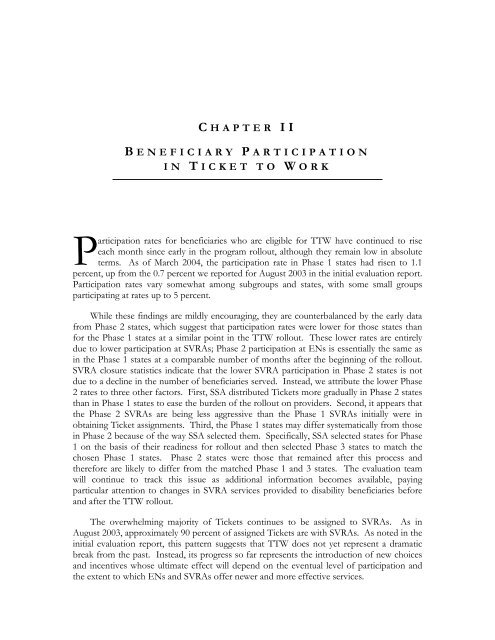Evaluation of the Ticket to Work Program, Implementation ...
Evaluation of the Ticket to Work Program, Implementation ...
Evaluation of the Ticket to Work Program, Implementation ...
Create successful ePaper yourself
Turn your PDF publications into a flip-book with our unique Google optimized e-Paper software.
C HAPTER IIB ENEFICIARY P ARTICIPATIONIN T ICKET TO W ORKParticipation rates for beneficiaries who are eligible for TTW have continued <strong>to</strong> riseeach month since early in <strong>the</strong> program rollout, although <strong>the</strong>y remain low in absoluteterms. As <strong>of</strong> March 2004, <strong>the</strong> participation rate in Phase 1 states had risen <strong>to</strong> 1.1percent, up from <strong>the</strong> 0.7 percent we reported for August 2003 in <strong>the</strong> initial evaluation report.Participation rates vary somewhat among subgroups and states, with some small groupsparticipating at rates up <strong>to</strong> 5 percent.While <strong>the</strong>se findings are mildly encouraging, <strong>the</strong>y are counterbalanced by <strong>the</strong> early datafrom Phase 2 states, which suggest that participation rates were lower for those states thanfor <strong>the</strong> Phase 1 states at a similar point in <strong>the</strong> TTW rollout. These lower rates are entirelydue <strong>to</strong> lower participation at SVRAs; Phase 2 participation at ENs is essentially <strong>the</strong> same asin <strong>the</strong> Phase 1 states at a comparable number <strong>of</strong> months after <strong>the</strong> beginning <strong>of</strong> <strong>the</strong> rollout.SVRA closure statistics indicate that <strong>the</strong> lower SVRA participation in Phase 2 states is notdue <strong>to</strong> a decline in <strong>the</strong> number <strong>of</strong> beneficiaries served. Instead, we attribute <strong>the</strong> lower Phase2 rates <strong>to</strong> three o<strong>the</strong>r fac<strong>to</strong>rs. First, SSA distributed <strong>Ticket</strong>s more gradually in Phase 2 statesthan in Phase 1 states <strong>to</strong> ease <strong>the</strong> burden <strong>of</strong> <strong>the</strong> rollout on providers. Second, it appears that<strong>the</strong> Phase 2 SVRAs are being less aggressive than <strong>the</strong> Phase 1 SVRAs initially were inobtaining <strong>Ticket</strong> assignments. Third, <strong>the</strong> Phase 1 states may differ systematically from thosein Phase 2 because <strong>of</strong> <strong>the</strong> way SSA selected <strong>the</strong>m. Specifically, SSA selected states for Phase1 on <strong>the</strong> basis <strong>of</strong> <strong>the</strong>ir readiness for rollout and <strong>the</strong>n selected Phase 3 states <strong>to</strong> match <strong>the</strong>chosen Phase 1 states. Phase 2 states were those that remained after this process and<strong>the</strong>refore are likely <strong>to</strong> differ from <strong>the</strong> matched Phase 1 and 3 states. The evaluation teamwill continue <strong>to</strong> track this issue as additional information becomes available, payingparticular attention <strong>to</strong> changes in SVRA services provided <strong>to</strong> disability beneficiaries beforeand after <strong>the</strong> TTW rollout.The overwhelming majority <strong>of</strong> <strong>Ticket</strong>s continues <strong>to</strong> be assigned <strong>to</strong> SVRAs. As inAugust 2003, approximately 90 percent <strong>of</strong> assigned <strong>Ticket</strong>s are with SVRAs. As noted in <strong>the</strong>initial evaluation report, this pattern suggests that TTW does not yet represent a dramaticbreak from <strong>the</strong> past. Instead, its progress so far represents <strong>the</strong> introduction <strong>of</strong> new choicesand incentives whose ultimate effect will depend on <strong>the</strong> eventual level <strong>of</strong> participation and<strong>the</strong> extent <strong>to</strong> which ENs and SVRAs <strong>of</strong>fer newer and more effective services.
















